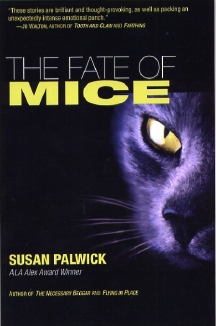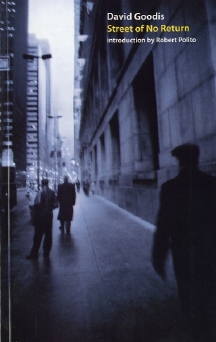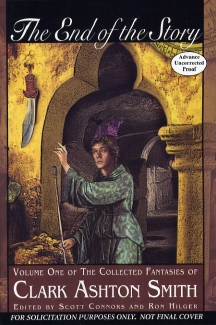Trashotron.com |
||
This Just In...News From The Agony Column
01-19-07: Juliet Marillier's 'Wildwood Dancing'
Sidestepping Into Reality
My first thought when I saw this book was that they had misspelled Patricia McKillip's name. After all, I'm accustomed to seeing the incredible art of Kinuko Y. Craft on McKillip's covers. But no, 'Wildwood Dancing' (Tor UK / Pan Macmillan ; December 1, 2006 ; £14.99 ; Alfred A. Knopf / Random House ; January 27, 2007; $16.99) is definitely a novel by Juliet Marillier. But clearly, nobody is messing around. Tor UK and Knopf clearly recognize the brand name that they've established with the combination of McKillip and Craft, and this novel is a really shrewd exercise in expanding marketing tactics. 'Wildwood Dancing' is aimed at the female YA market, probably the only expanding market at the moment. It's the kind of thing that might make you not want to read the book before you even opened it up, and that would be a mistake.
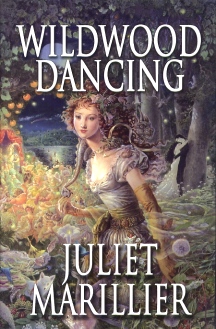
Believe your eyes. Craft on the cover, writerly craft within.
Marillier's usual milieu is high fantasy; The Sevenwaters Trilogy, The Bridei Chronicles, Foxmaski and Wolfskin. So it’s not that much of a stretch for her to tackle a sort of girly fantasy. For this reader, such a stretch would tend to be uninteresting. I'm the polar opposite of the intended audience, crabby old man as opposed to happy young gal. But credit Marillier with bringing her formidable talent to the task of writing a YA novel, to the point where it becomes intriguing even to those who might first suspect it of being an inspired marketing ploy.
'Wildwood Dancing' is inspired all right, but not by the marketing department. They’re just the lucky beneficiaries of the elements it seems that Marillier has been marinating for years. 'Wildwood Dancing' is a gorgeously written, carefully crafted conflation of fairy tale and magic realism, of suspense and fantasy, of surrealism and wish-fulfillment. But then seeing one's wishes fulfilled would be rather surreal, wouldn't it? As the novel begins, Jena and her sisters have a secret. For nine years, they’ve been able to travel to the Other Kingdom, a realm more fantastic than their native haunts in the mountains of Transylvania. When their father falls ill, Jena and her older sister Tati are left in charge. Jena benefits greatly from the help of Gogu, the frog whose thoughts she knows. But even Gogu can't help her out maneuver Cezar, the grasping cousin who wheedles his way to control. Things go from different to bad to worse.
Except so far as Marillier's writing is concerned. 'Wildwood Dancing' is something of a revelation, showing how Marillier's skill as a fantasy writer can be put to powerful use when she turns her hand to YA fiction. I really couldn’t care that this was a YA title. Marillier captures the timeless charm and darkness at heart of a good, slightly vicious fairy tale, and turns it into something of a toe-tapping thriller. It's really her command of language that shines brightly. Evocative and atmospheric descriptions are complimented by a sleek, transparent prose style. 'Wildwood Dancing' is no less than your best memories of reading fairy tales brought to life for your reading as an adult. Marillier convincingly compels to turn the page, dares you to descend into her underworlds. Classify this as yet another novel not to be read at the bookstore unless you wish to buy it. Marillier has earned her Kinuko Y. Craft cover.
01-18-07: Susan Palwick Contemplates 'The Fate of Mice'
Twenty Years On
We live in an age of specific expectations, particularly where writers are concerned. There will be one novel per year. There may be some short stories in that year if the writer in question is inclined. End of stories.
Susan Palwick is not one to submit to schedules or expectations other than her own. 'The Fate of Mice' (Tachyon Books ; March 2007 ; $14.95) is her third book in twenty-one years. But given that her other two books were the novels 'Flying in Place' and 2005's 'The Necessary Beggar' need not either worry or hurry. 'The Fate of Mice' collects over twenty years of short stories, each of them gem-like and pristine. Palwick offers the kind of variety that we find in our best, our most powerful and versatile authors.
'The Fate of Mice' includes eleven stories and runs 218 pages; three of the stories are original to this volume. But in this brief space, Palwick displays a range reminiscent of the greatest writers, the ability to engage the imagination on any level required -- by the story. Palwick's work is finely honed, carefully crafted and each piece has the sort of full feeling that suggests the world it describes extends well beyond the boundaries of the story itself.
'The Fate of Mice' begins with the title story, a poignant peek told from the point of view of an intelligent mouse. Freedom, it proves is more problematic than one might imagine. Palwick writes with the kind of conviction that is simultaneously fierce and funny, using her SFnal leap to shine the light upward. It's an interesting perspective. Other stories delve into the horror genre ("Gestella"), anti-utopian utopian fiction ("The Old World"), and even the post-apocalyptic love story ("Sorrel's Heart"), one of three stories new to this volume. 'The Fate of Mice' is not a giant book in a giant package. It’s not another drumbeat in a career that keeps the beat. It's evidence that there exists that rarest of creatures, a talented writer who writes what she cam what she must. It is evidence that though independent publishers are themselves practically an endangered species, they still manage to thrive, they still deserve to thrive. In our age, we may not expect much. Look deeper into your bookstore and shelve your expectations. This slim collection has an overwhelming effect on the reader. Enough, perhaps to keep you going for another twenty years.
01-17-07: The Bitter End and Better Fiction
Millipede Press Reprints David Goodis
David Goodis sought the darkness, and brought it to light. By any measure of today's standards he earned success beyond imagination, yet his life was a downward spiral of failure and depression. He drifted through three remarkable careers as a writer and never knew his own success, was always a failure in his own estimation. He knew everyone including himself, but the knowledge was no savior. Having judged and found himself guilty, he carried out his sentence with the ruthless, thuggish enthusiasm about which he wrote so passionately.
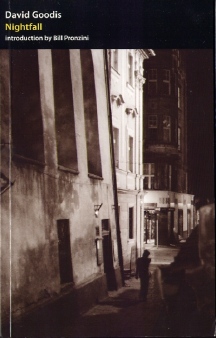
Not the best part of town.
Hindsight of course is ever perfect, and in hindsight we might reasonably view Goodis as a flawed icon, his work tainted by the subject the consumed him. Goodis gazed into the abyss and didn't care if it gazed back. It was only within the darkness that he would ever find succor.
Born in 1917, he earned a degree in journalism, then took his first job at an advertising agency in Philadelphia. During nights and weekends, he wrote his first novel, a work of literary fiction titled 'Retreat from Oblivion'. It failed on all fronts, and the disheartened author decided to scale back his efforts and began grinding out pulp fiction. His novels didn't sell, but his pulps did, well enough that he could quit his job and devote himself to writing full time. He wrote air combat fiction for magazines with titles like Fighting Aces, Battle Birds, and Lone Eagle. He wrote horror, crime and western stories for magazines like Terror Tales, Dime Mystery, and Western Tales. Like many successful pulp writers, he produced not the best work but the most timely. Deadlines loomed and his work was hastily written, poorly edited and shabbily printed. But it was work, and today just the titles of these magazines evoke a sense of book dust and dark rooms. The forbidden and the forgotten.
Goodis found employment writing for radio serials, writing for Superman and Hop Harrigan, names now iconic, but Goodis just dashed off the work and moved blindly forward, still searching for the buzz that success writing mainstream literary fiction would provide. Instead, he ended up in Hollywood doing uncredited script rewrites. In 1945 he finally published his second novel, 'Dark Passage'. Yes, that 'Dark Passage'. Bogart and Bacall. He had made it, got a contract with Waarner Brothers. But of course, his journey was not yet over, and the title of his first success could not have been more appropriate.
But he didn't get the gigs he'd hoped for despite his initial success. He adapted Chandler's 'The Lady in the Lake', but it was never produced. Instead of the A-list he'd hoped for he was writing B movies, and true crime reporting, including a look at the Black Dahlia murder for The San Francisco Chronicle. Drawn by the darkness, disappointed by his own failures, he began to live a life like those he wrote about, haunting the worst parts of town in the depths of night, seeking the solace of prostitutes and after-hours booze clubs. It didn't help his reputation, and after his contract with Warner expired, they cut him loose.
Goodis left California, moved back to Philly with his parents and schizophrenic brother, and embarked on his third career, writing cheesy paperback novels for Fawcett Gold Medal and Lion Books. He wrote during the day and lived the life at night, plunging further into depression and self-destruction. 'Down There' was filmed as Shoot the Piano Player by Francoi Truffaut starring Charles Aznavour. He wrote an episode for Alfred Hitchock's television show. In the manner of a true writer, he wrote about what he knew, and published novels of violent losers on a downward spiral. His novel 'Nightfall' was adapted by Sterling Silliphant and turned into a movie by Jacques Tourner, but it was no barn-burner. He eventually died of cirrhosis of the liver in 1967, just before he was fifty.
Looking back on his resumé now, Goodis seems to have lived a life both charmed and cursed. He was a success in fields now iconic to popular culture. The pulps. The movies, Noir paperback fiction. Bogart and Bacall, Tourner and Hitchock, Truffaut and Azznavour. Yet he remained unaware of his own virtues, unaware that the weaknesses he mined for material were undermining his ability to comprehend his own strengths. His work might not be perfect, but it comes from a place that no longer exists except in the world of fiction. Goodis haunted the back alleys that we see re-created today in film and in print.
Bringing Goodis himself back in print is Millipede Press, with two more handsome trade paperbacks. 'Street of No Return' (Millipede Press ; April 2007 ; $14) and 'Nightfall' (Millipede Press ; May 2007 ; $14) off the kind of extras that one hopes to find in more expensive editions. 'Street of No Return' features an introduction by Robert Polito, an extra short story by Goodis titled "Black Pudding" and reset, re-designed text. 'Nightfall' gets an introduction from Bill Pronzini, the same reset/re-deigned text and a short story titled "The Blue Sweetheart". I confess: I mined Pronzini's intro for most of the info here, simply because it seemed such a great story to me, such a great example of how the darkness within always seems to win. It makes us and destroys us. If only we knew what we are, what we could become. If only we could bring it to light.
01-16-07: Clark Ashton Smith at 'The End of the Story';Podcast High-Quality Version of NPR Economic Genre Fiction Report
Beginning at the Beginning
When I saw 'The End of the Story: Volume One of the Collected Fantasies of Clark Ashton Smith' (Night Shade Books ; April 10, 2007; $39.95), edited by Scott Connors and Ron Hilger, I thought in theory that though this was a book I would certainly want, it might not be a book I'd need. But alas, I have the book to hand, not just in theory. The book in fact, words and all, suggests that it's beyond desire, beyond need. It is required.
I don’t say that lightly. Clark Ashton Smith has long been one of my favorite writers from the Old Weird generation. You know, H. P. Lovecraft, Robert E. Howard, Lord Dunsany. The Old Weird. I can still see in my mind the huge book rack they had at the Lucky Store in Covina, California. That's where I bought a substantial number of the original Bantam Adult Fantasy series, edited if I'm not mistaken by Lin Carter. 'Fungi from Yuggoth', poems by H. P. Lovecraft. 'At the Edge of the World', short stories by Lord Dunsany. And 'Poseidonis' by Clark Ashton Smith.
These books were supreme enablers. They led me directly to the Arkham House editions of Lovecraft, the first hardcovers I purchased that I really, really cared about. And thence unto the now.
Enablers. And when you get drugs as good as 'A Rendezvous in Averoigne', the 1988 omnibus from Arkham House, edited by the late Jim Turner, illustrated by J. K. Potter, I'm telling you, it's a hard high to top. That's the sort of volume that should really be in every book-lover's collection, regardless of your tastes. The combination of Smith's ornate prose, Arkham's pristine production and Potter's surreal mind-captures create a reading experience like no other.
And thus it remains. But Night Shade knows their way around the Old Weird better than anybody out there, and this new series of books promises to be beyond mere desire. They are not a nice-to-have, but a need-to-have. Yes, you still need the Arkham House, to be sure. But, alas, Smith's addictive prose is drug-like, and the architecture of this series promises to make it indispensable. Let Arkham House be the executive summary. Let Night Shade be the contact itself.
You're not reading this column because you can take it or leave it when it comes to reading unusual and under-publicized fiction. There are a couple of reasons that make 'The End of the Story' the beginning of a beautiful addiction. The first is the methodical architecture of the series. There will be five books, we're told, so the total investment is $200. This seems a very reasonable price to me; I've paid that much for single volumes worth, in retrospect, much less in terms of re-reading pleasure. But here's the Big Appeal, part one. The stories are offered in the order of composition, based on Smith's notes. For me, this is ideal. As a reader, I like to experience a writer's work in the chronological order in which it was composed, so that I, as a reader can get to know a writer, to watch them grow and see their style change. This then, makes that possible and easy for Clark Ashton Smith. While I like the typical trend of grouping the stories by theme, and that is indeed an excellent way to read them in order to become familiar with Smith's worlds, this collection offers readers the chance to become familiar with Smith himself as a writer. This alone puts this in the required column.
But editors Connor and Hilger, in association with Jeremy Lassen and Jason Williams at Night Shade, have done much more than this. They've taken advantage of the generosity of Arkham House itself as well as the Smith estate, to create the ultimate compendium of Smith's work. Look, you're reading the stories here to experience the man as well as his worlds, and to that end what do you want? Extensive story notes, the sort of literary detective work that comes at the back of this volume. The kind of well-written, informative and thoroughly documented notes you find here are exemplars, and themselves sort of short stories. Reading the story, then the notes, you'll embark on a dual journey, into the world created and the mind of, the world of, the world's creator. This is fascinating stuff, and very different reading experience from that of the Arkham House. Connor, Hilger and Night Shade are to be congratulated.
If you've made it this far without pre-ordering, then you’re made of sterner stuff than I. Perhaps this is because you didn't stand there in the Lucky's Grocery Store in 1970 and stare at the racks, your mind full of idiocy and wonder. Perhaps you never bought the 1988 omnibus edition, never had the chance to luxuriate in Smith's prose and Potter's visions. Well, Lucky's is not more, so no luck there. But you if you've somehow missed Smith altogether, then you can still find copies of the justifiably iconic 'Rendezvous in Averoigne'. It'll set you back some $34-$100. Buy it and read it, and then step outside your door. Raise your arms to the skies and curse the day you read this and me as well. Then step inside and order this volume. Sign up for the whole series. Better to buy it now, new, than later, used and much more expensive. It's not what you want; it's what you need.
EconGenre
I've just uploaded a high-quality MP3 version of the report I did for NPR on Economic Genre Fiction. This is high fidelity version created from the edit and including the promos that NPR used, which themselves include some great background music for TC Boyle. Thanks again to listeners and reader who wrote both me and NPR. Your help in making this a popular piece on NPR will be used to serve you, the listeners and readers more interviews with fascinating writers and artists. Once again thanks. Here's a link to the MP3; it's also in the audio archive and included in the podcast stream.
01-15-07: "That's the gnarly zone"
A 2007 Interview With Rudy Rucker

Rudy rucker seeks the gnarl at KUSP. Rudy Rucker, rules, OK? I had the opportunity to speak with him the afternoon before his appearance at Capitola Book Café, having just finished the wonderful novel 'Mathematicians in Love', and we had a great conversation, some of which was even recorded for your listening pleasure. Rucker is the author of about a bazillion titles, most of them iconic, from the "ware" series, 'Software', 'Wetware', 'Freeware', 'Real Ware', to non-fiction works like 'The Lifebox, the Seashell and the Soul'.
Rucker is rather unique among science fiction writers, and a great Santa Cruz type of personality, by which I mean he's incredibly smart, highly perceptive with a peculiar and bizarre imagination. And in spite of all that, he manages to remain really funny and a guy with a sort of sunny outlook. Even if the world is going to hell in a handbasket, Rucker is going to suss out just how intricate the path there might be and why, when we arrive, we might find that our destination has been changed mid-journey without our knowledge.
I spoke with Rucker about the beginnings of the cyberpunk movement, and he told me about his love of the Beats and about the high point of cyberpunk, when Mondo 2000 ("Their idea of using computers was to...take drugs and imagine they were having telepathic contact.") was on the cover of Time Magazine. Since Rucker has written a great deal of non-fiction about the future, I was pretty curious to have his take on futurology: "It's not terribly different from science fiction. I guess it tends to be more grasping, more humorless, less interesting...more bogus."
We also talked about THE GNARL, a phrase in found frequently not only in 'Mathematicians in Love' but also in Kim Stanley Robinson's 'Sixty Days and Counting', the conclusion to his Science in the Capital series. It's a key to understanding what Rudy is up to and why he is up to it. And a word you'll hear frequently on the beaches of Santa Cruz.
We talked about Rudy's new short story collection from Thunder's Mouth Press, 'Mad Professor'. It is a collection of the uncollected. That is the sort of paradox that Rucker loves to make readers wrap their tiny brains 'round. Featuring collaborations with Bruce Sterling, John Shirley, Paul Di Filippo and his son, Rudy Rucker, Jr., 'Mad Professor' reminds me of some of my favorite Lem collections. Rucker has the ability to be both profoundly insightful but delightfully goofy in the same work. In the interview, you'll hear the story behind the collaboration with his son, which will propel you to the bookstore as if you had a jetpack. We'll have more about our lack thereof coming soon.
I have to apologize to those readers who find themselves wanting to buy Rucker's entire back-catalogue once they hear this interview, but at least you can read Rucker's blog while youwait for the books to arrive or check out Flurb, his mind-bogglingly good webzine. Cory Doctorow. Marc Laidlaw. John Shirley. Free. Totally, one hundred percent wsild. Rucker told me after the interview that he started Flurb with the intent of publishing the (commercially) unpublishable. Trouble is, once folks get wind of how good the supposedly unpublishable is, someone will pay him to publish it. Look for a Best of Flurb from Thunder's Mouth press, in like, say, two years? I'll give it two years. Hey, that leaves you three years to read and re-read it before the usual End of the World arrives in five years. You know, we only have five years, right?
In the interim, you can enjoy the MP3 copy, torment yourself with the low-bandwidth friendly but sadly encumbered by DRM RealAudio file. Hey, it takes forever to create one of these friggin' RA files, and I have to use a super-down-rev version of Peak to do it. I trust by now you are subscribed to the podcast. Now is the time, folks. Join Rudy Rucker. SEEK THE GNARL.
